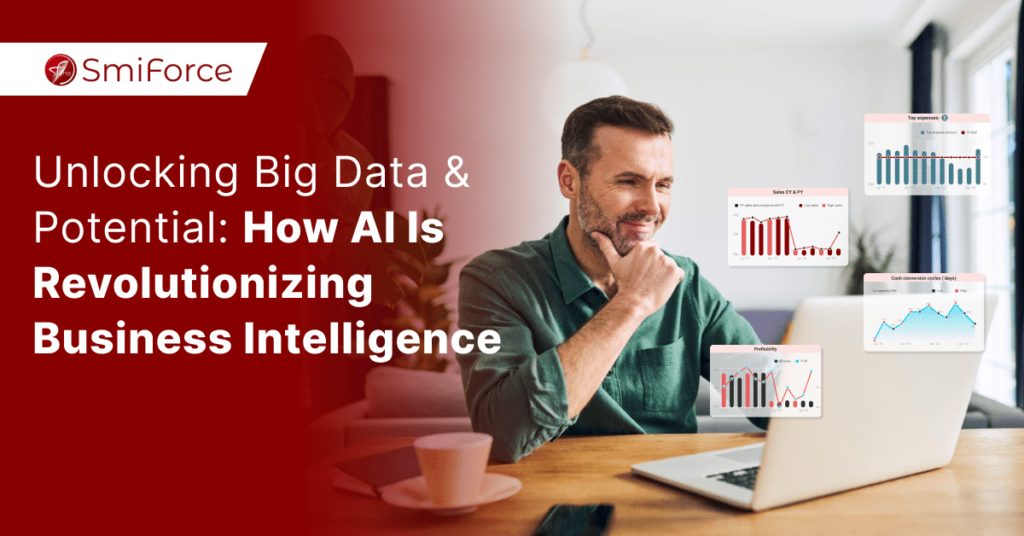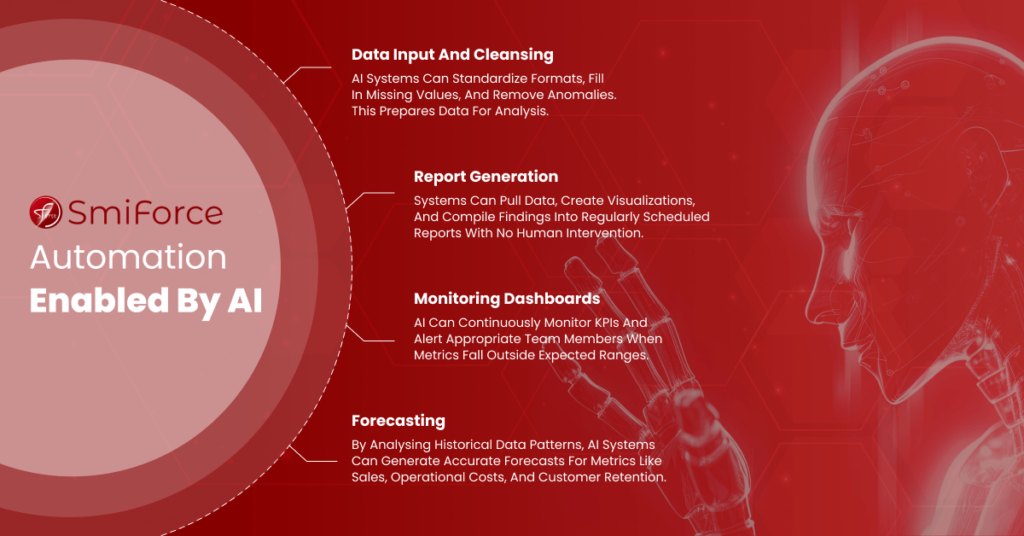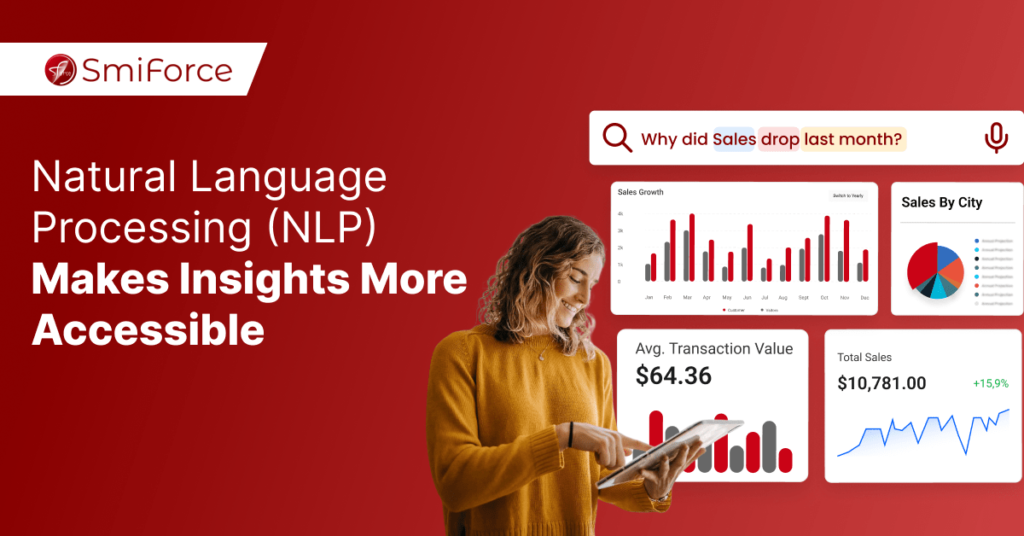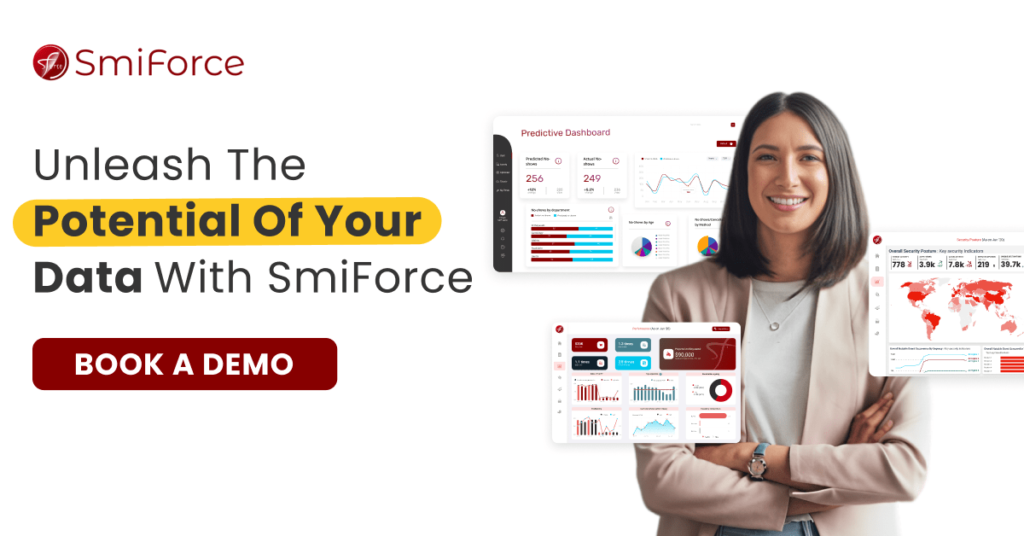
Introduction
Artificial intelligence (AI) is transforming industries across the board, from healthcare to manufacturing and beyond. AI refers to machine systems that are capable of tasks that have historically required human intelligence, such as visual perception, speech recognition, and decision-making. With machine learning algorithms, AI systems can continuously improve their capabilities based on new data.
Business intelligence (BI) is the broad process of collecting, storing, and analyzing data to make more informed business decisions. BI tools aggregate data from disparate sources and translate information into reports, dashboards, and visualizations. The goal is to uncover trends and insights that can improve operations and strategy.
AI is rapidly transforming BI by taking it from retrospective to predictive analytics. By combining massive datasets with cutting-edge techniques like machine learning, AI enables BI systems to deliver actionable insights in real-time. Rather than merely reporting on what has already happened, AI allows BI to forecast future trends and prescribe recommended actions. This powerful combination of technologies promises to revolutionize data-driven decision-making across industries.
Enhanced Automation

One of the biggest advantages AI brings to business intelligence is enhanced process automation. AI systems can be trained to handle repetitive, mundane tasks that would normally require a human analyst. This frees up analyst time and ensures consistency in repetitive processes.
Some examples of automation enabled by AI include:
- Data input and cleansing – AI systems can standardize formats, fill in missing values, and remove anomalies. This prepares data for analysis.
- Report generation – Systems can pull data, create visualizations, and compile findings into regularly scheduled reports with no human intervention.
- Monitoring dashboards – AI can continuously monitor KPIs and alert appropriate team members when metrics fall outside expected ranges.
- Forecasting – By analyzing historical data patterns, AI systems can generate accurate forecasts for metrics like sales, operational costs, and customer retention.
The efficiency gains from automating these types of repetitive tasks are massive. Analysts no longer waste time on routine data tasks and can instead focus on higher-value analysis and strategy. AI augments human capabilities, handling the mundane while analysts focus on the advanced.
Real-Time Insights
One of the key limitations of traditional business intelligence is its inability to provide real-time data insights. BI tools are great at analyzing large batches of historical data to uncover trends and patterns. However, they fall short when it comes to generating insights in real time.
This is where AI and machine learning can fill the gap. AI algorithms leveraging neural networks can process streaming data as it arrives. This allows for real-time anomaly detection, forecasting, and predictive analytics.
For example, an e-commerce company can get instant notifications when there are unexpected spikes or drops in website traffic or sales. The AI system can then adjust its recommendations and marketing strategy accordingly. Financial services firms are using AI to detect fraudulent transactions as they occur.
Overall, the combination of BI and AI provides the best of both worlds. BI offers robust data visualization and analysis of historical information. AI enables continuous real-time insights and adaptation. Together, they give businesses an intelligent decision-making framework that reacts to changing market conditions in real time. This is the future of data-driven decision-making.
Unstructured Data Analysis
Traditional business intelligence has mainly focused on analyzing structured data like sales figures, customer information, etc. that neatly fits into tables and databases. However, a wealth of valuable data exists in unstructured formats like social media posts, surveys, call canter logs, and more.
Manually processing such qualitative, subjective data used to be time-consuming and prone to bias. AI and machine learning algorithms, however, can efficiently analyze unstructured data at scale to extract insights.
AI techniques like natural language processing can interpret free-form text data to identify trends, perform sentiment analysis, and extract keywords. Voice analysis tools can process call center recordings to optimize customer service. Image recognition can analyze pictures and videos shared on social media to gauge brand perception.
By incorporating unstructured data analysis, businesses get a more holistic view of their operations and customers. They can connect insights from hard numbers as well as subjective sources to make smarter and more informed decisions. AI augmentation has expanded the scope of business intelligence to new realms of qualitative data.
Natural Language Processing (NLP) Makes Insights More Accessible

Even with business intelligence technologies, analyzing massive amounts of data can be a daunting task. Professional data analysts need to pore through hundreds of charts and dashboards to gather the necessary information. AI, however, can make things easier. Natural language processing and machine learning are bridging the gap between machine and human communication. AI enables robots to better understand human language, and vice versa, making it easier for data analysts to spot correlations and insights.
AI-powered BI allows businesses to analyze a wider range of data, including both structured and unstructured data, to gain more detailed and comprehensive insights. NLP specifically helps analysts derive meaning from textual data like customer reviews, social media posts, support tickets, and other sources.
By processing language in a way that’s closer to human understanding, NLP enables analysts to turn qualitative data into quantitative insights. This bridges the communication gap between humans and machines.
Also Read – SmiForce’s Generative AI Integration: Unleashing Your Data’s Potential with a Single Question
Data Visualization
When data comes in from multiple sources, it can be difficult for dashboards to present it in an easy-to-read format. However, with AI, the data can be specified at scale, making it easier to gain meaningful insights.
Traditional business intelligence dashboards can become cluttered as more data sources are added, making it difficult to spot important trends and insights. AI optimizes dashboards by identifying the most relevant metrics and key performance indicators to display. By focusing on the highest-impact visuals, dashboards surface the key takeaways without overwhelming users.
AI also enables new visualization capabilities through machine learning algorithms. By analyzing large volumes of historical data, AI can detect subtle patterns and correlations that might not be visible to the human eye alone. These insights can then be translated into compelling interactive charts, graphs, and maps.
Advanced natural language processing allows users to query data sets using plain language. Instead of requiring specialized knowledge of query languages, users can simply ask questions in natural speech to automatically generate relevant visualizations. This makes it easier for a wide range of business users to take advantage of complex data. Overall, AI augmentation allows dashboards to go from static reporting tools to smart, interactive visual aids. This empowers users at all levels of an organization to make better real-time decisions through optimized data visualization capabilities.
Data Visualization
The field of data analysis suffers from a shortage of qualified professionals. By 2025, demand for data analysts exceeded supply. This talent shortage makes it difficult for companies to take full advantage of their data. There simply aren’t enough human analysts to make sense of all the data.
AI and machine learning can help fill this gap in two ways:
- Automating Data Analysis Tasks: AI can take over some basic data gathering and analysis responsibilities traditionally performed by analysts. This allows the existing analyst team to focus on higher-level tasks and strategic initiatives.
- Augmenting Human Capabilities: AI also serves as a productivity enhancer for data analysts. The technology can preprocess data, spot anomalies, and identify relationships and patterns. This allows the human analyst to operate at full potential by focusing solely on the interpretation and value-add of Insights. Rather than replacing analysts, AI makes them better at their jobs.
The combination of automation and enhancement allows companies to extract more value from their data, even with a limited analytics team. AI helps get the most out of both technological capabilities and human expertise.
Time Savings
Artificial intelligence automates routine and repetitive tasks, freeing up employees to focus on more value-added work. Studies have shown that employees spend a large portion of their time on administrative tasks that AI could easily handle.
For example, UK employees waste millions of days every year on time-consuming tasks according to Entrepreneur Magazine. Similarly, a workplace study by AtTask and Harris Interactive found that US employees spend only 45% of their time on their primary responsibilities.
By automating mundane tasks, employers can reduce the amount of time wasted on low-value work. Rather than data entry, report generation, and other repetitive jobs, employees can spend more of their day focused on core business objectives. The capabilities of AI allow machines to consistently execute tasks based on predefined parameters and norms.
With AI implementation, organizations experience increased productivity as employees can dedicate their efforts to more strategic initiatives. The efficiencies created by task automation also led to higher job satisfaction as workers were empowered to take on more meaningful responsibilities. Ultimately, artificial intelligence enables businesses to reduce time spent on repetitive tasks, boost productivity, and unlock employee potential.
In Conclusion: The Future of Business Intelligence with AI
The integration of Artificial Intelligence (AI) into Business Intelligence (BI) has been nothing short of revolutionary. This synergy has transformed how we process, analyze, and leverage data, paving the way for smarter, faster, and more intuitive decision-making. Here’s a quick recap of what this means for businesses:
- Automated Processes: AI streamlines data analysis, reducing manual effort and increasing efficiency.
- Real-Time Insights: Move beyond static reports to dynamic, real-time analytics.
- Accessible Data Analysis: Natural language processing allows for simpler, more intuitive data queries.
- Advanced Visualization: Identify trends and patterns more easily with sophisticated visualization tools.
- Cross-Industry Applications: From healthcare to retail, AI-enhanced BI is reshaping how industries operate.
Discover SmiForce: Elevating Your Business Intelligence to New Heights with AI
Intuitive, AI-Powered Insights at Your Fingertips:
- Seamless Integration: With SmiForce, disparate data sources coalesce into a unified, potent stream of insights, breaking down silos and fostering comprehensive analysis.
- Natural Language Processing (NLP): Forget complex queries. Ask questions in plain language and get answers instantly. SmiForce’s intuitive interface makes data analysis as easy as having a conversation.
- Automated Machine Learning: Dive into the depths of data with our self-learning algorithms. Whether it’s pattern recognition or predictive analytics, SmiForce makes advanced data modeling simple and accessible.
Revolutionizing Decision-Making Across Industries:
- Whether it’s retail, finance, healthcare, or manufacturing, SmiForce tailors its capabilities to fit your industry’s unique needs, delivering not just data but actionable insights.
A Leap Beyond Traditional BI Tools:
- Smart Data Search: Say goodbye to SQL complexities. Our natural language search offers a more human, less technical approach to data exploration.
- AI-Designed Analytics Insight: Jargon-free insights are now a reality. SmiForce translates complex data into clear, actionable information.
- Data Synchronization: No more data in silos. SmiForce harmonizes data from multiple sources, providing a 360-degree view of your business landscape.
Ready to Use, Ready to Transform
- From day one, SmiForce offers a ready-to-go, AI-powered platform, tailored for both data novices and seasoned analysts. Start unlocking the potential of your data with minimal setup and maximum impact.
Customization at Its Core
- Every business is unique, and so are its data needs. SmiForce isn’t just a tool; it’s a partner, ready to develop custom models that fit your specific requirements. Empower Your Business with AI-Driven BI
- In the rapidly evolving world of data, SmiForce is your guide. It’s not just about keeping up; it’s about leading the charge.
Why Wait? The Future of BI is Here with SmiForce
Join the ranks of businesses redefining their data strategy. Experience the power of AI-enhanced BI with SmiForce and turn data into your most powerful asset.


